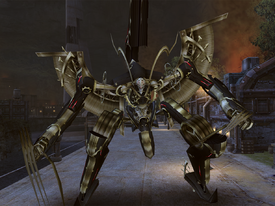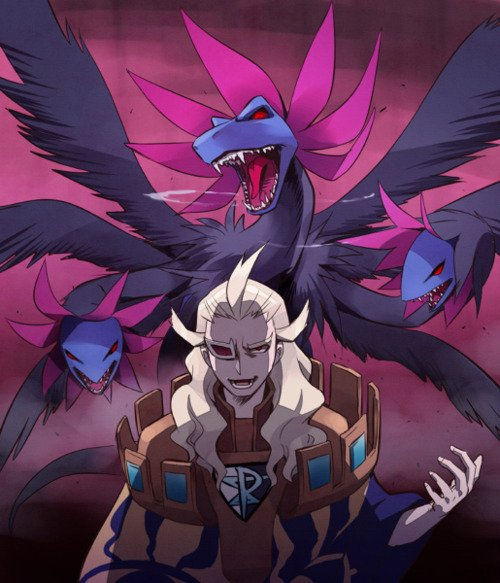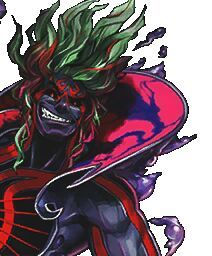The Well Developed Villain
- Reed Priest
- Dec 5, 2018
- 6 min read
Updated: Dec 17, 2018
(Minor spoiler warning)
Villains are a common feature in any story or game. They counter the player’s philosophy, offering a challenge to overcome and an intellectual battle to wage in justifying the player’s motives. A story would be rather bland without conflict, and villains offer the dynamic action to enrich a story or game. Villains are separate from rivals, however. Rivals counter the player, yes, but they are not inherently evil or morally ambiguous; villains, on the other hand, often adopt a sense of evil or moral ambiguity that offers a justification to defeat them: the classic good versus evil battle. While there are many villains who are characterized as “being evil for evil’s sake,” the strongest villains that make lasting impacts on the player involve deeper processes.
The literary vampire

A villain with a lasting impact motivates the player. We see this profoundly in Xenoblade Chronicles with the robotic villain Metal Face. Aside from his striking design and gravelly voice, this character stands out due to his role as a literary vampire. Literary vampires, originating from Dracula, connect with the player because these characters take something important from the player. This theft drives the player for justice or revenge against the villain. Metal Face is a literary vampire because he steals the life of Fiora, the protagonist’s best friend and potential love interest. Just enough time passes in the game to first become emotionally connected with Fiora so that the villain could snatch her life away and produce an emotional unrest. This dramatic twist paired with an emotional score and cutscene drives the character to avenge Fiora’s death. This motivation offers both intensity and direction to justify the player’s epic journey.

Similarly in Xenoblade Chronicles, a villain by the name of Xord employs this tactic. As another robot with massive frame and power, Xord kidnaps Juju - one of the player’s acquaintances - thereby motivating the player to find and return their friend. In doing so, the player organically becomes close with Sharla, Juju’s loving sister who joins the player’s party in seeking to return Juju safely. Thus, story enriches gameplay variety. At the climax when the player meets Xord, a unique back-and-forth occurs. Xord displays a wealth of character depth, acting as some sort of demented party host where the main course is humans; Xord has a history of killing and devouring his human prey, adding an eerie layer to his demeanor. In this moment, Xord has stolen what the protagonists value, and also threatens the safety of the protagonist, thereby offering a moral justification for his demise. In response to this challenge, Sharla swears that she will stop this metal monster to save her brother, similarly rousing the player to overcome this opponent. Metal Face and Xord’s character depth and behavior of violating what the player values produces the drive to avenge losses and overcome daunting challenge.
Repeated Meetings

Instead of meeting the protagonist in a one-time interaction, most well-developed villains require time to fully develop. Thus, having villains combat the main character several times as both entities strengthen creates a rich bond of competitiveness between the two. Consider Berkut from Fire Emblem: Shadows of Valentia. As the nephew of the evil Emperor Rudolph, Berkut is a mighty force to combat. He occasionally surprises the player with an unexpected battle, bringing only a few troops because he relies mostly upon his own strength. These meetings occur several times, and ripen both Berkut’s and the protagonist’s characters due to their philosophical differences. Their clashes are not only physical, but also intellectual as they debate who has ultimate power: commoners or the socially elite. The battlefield is a representation of the conflict between their ideals. Initiating this rich clash several times allows further development for both forces, subsequently making Berkut a more believable and relatable character.
A relatable philosophy

As previously stated with Berkut’s character, a philosophical clash between the protagonist and the villain helps flush out who the villain truly is. Ogres have layers, and so does a well developed villain’s philosophy. Ghetsis from Pokémon Black and White, for example, demonstrates a powerful philosophy that initially conflicts with every assumption that Pokémon exercises. He posits that Pokémon should be free from human captivity and should not be used in battle. The entire series of Pokémon argues that Pokémon are friends to humans, and through battling, trainers become closer and more understanding of their Pokémon. Ghetsis’s philosophy makes this relationship appear unethical and rather akin to slavery, forcing the player to wrestle with this argument throughout the entire game. The pursuit of truth between Pokémon and people motivates the player to further understand what should be done for both races.
A real personality

Instead of acting evil for the sake of being evil, delectable villains offer a dynamic, intricate personality that justifies their clash against the protagonist. Klaus Walz from the game Valkyria Chronicles 4 is a strong example due to his shamelessly romantic side. He is often seen courting women amid a battlefield of tanks, perfectly clashing the bliss of romance with the brutality of war. After an encounter with the player, Klaus considers the player a worthy adversary, bestowing the nickname “soulmate” upon him/her. This brand forms a connection between the player and the enemy. Whenever the two combat, Klaus always adds his kind of romantic humor to the mix. At one point, for example, he must abandon a battle, and paraphrases Shakespeare’s Romeo and Juliet: “Parting is such sweet sorrow, my soulmate.”

Hades from Kid Icarus: Uprising is another illustrative example of villain depth through personality. Hades is not the typical villain of austere power and undeniable evil; instead, he is humorous, nonchalant, and witty. The coyness and slyness about his character gives the player a false sense of security until Hades unleashes his real power. Hades’s personality, then, offers a shock to gameplay, thereby enriching the player’s experience.
While these two villains exemplify how humor can craft a villain, mystery can also richen a villain’s dynamic. Once again with Xord from Xenoblade, the player notices a substantial amount of ambiguity and humanization in this metal hulk of an enemy. In a fleetingly soft moment, Xord hollowly reminisces that he can’t remember his real name, and that “Xord” is merely a name bestowed upon him by the army. This moment begs the player’s curiosity. While Xord appeared to be evil for evil’s sake due to his behavior of eating humans, he has a complicated backstory that is never fully explained. This intrigue weighs on the player because they are now fighting an entity that is nostalgic and regretful, rather than just purely evil.
Love to hate or hate to love

The way I most often assess an antagonist’s significance is whether or not I love to hate or hate to love this villain. To explain the love to hate dynamic, consider Gangrel from Fire Emblem Awakening. Gangrel is the mad king from a neighboring kingdom who shamelessly strives for war between the two lands. His wild and crazed nature demonstrates itself in the final clash between himself and the player. Most bosses in Fire Emblem games do not move; rather, they stay to the rear to strategically use their units to fight rather than risk putting themselves at risk in the fray. In his madness, Gangrel abandons this strategic norm and charges the player’s army. The most appropriate strategic response is to similarly rush him before he cuts down any isolated units. By forcing the player’s hand at a crazed strategy, Gangrel subtly challenges the player to become mad as he is. This dramatic twist on gameplay, his powerful voice acting, and his propulsion of the game’s plot with Emmeryn's death (too intricate to cover here) makes Gangrel a character that I love to hate.

Conversely, there are also villains in games that I hate to love. These are characters that I do not want to empathize with their position, but I cannot help doing so due to their development and humanization. Emperor Rudolph, another Fire Emblem “villain,” is a driving force in the Fire Emblem Echoes: Shadows of Valentia's plot. He is rumored to be a cold, harsh leader with no sympathy for those he conquers. To counter this preconceived expectation, the player overhears Rudolph amid the final battle telling his men to surrender if he falls before they do. He conveys to his men that they have families and duties beyond his own, and that their lives should not be wasted if he falls. This moment of mercy counters everything the player previously anticipated from this massive opponent. Before the player can meditate upon this intention, the battle ignites. In his final moments, Rudolph whispers kindness and duty upon the protagonist (along with some VERY intense plot components that deserve a full review on their own). When Rudolph falls, the player can finally evaluate the man he/she just slayed. After some thought, the usurping of this king no longer appears just. Had the protagonist and player known of Rudolph’s true intentions and hidden kindness, would they still slay him? This moment reshaped everything I knew about Rudolph. And if you’ve played Fire Emblem: Echoes, you understand why this moment is so pivotally turning. After this exchange, I could no longer despise Rudolph; instead, I felt more sympathy than spite. I hated it, but I loved his character. Rudolph exemplifies how some characters can reach depth because the player can hate to love them.
Summary
There are many components that help create strong villains. Plot, characterization, and drama all interact to enrich the gameplay experience. Villains drive the player and enable the player’s epic journeys. By constructing rich, intricate villains, game designers enrapture the player with unexpected meaning and weight to their gameplay.



Comments